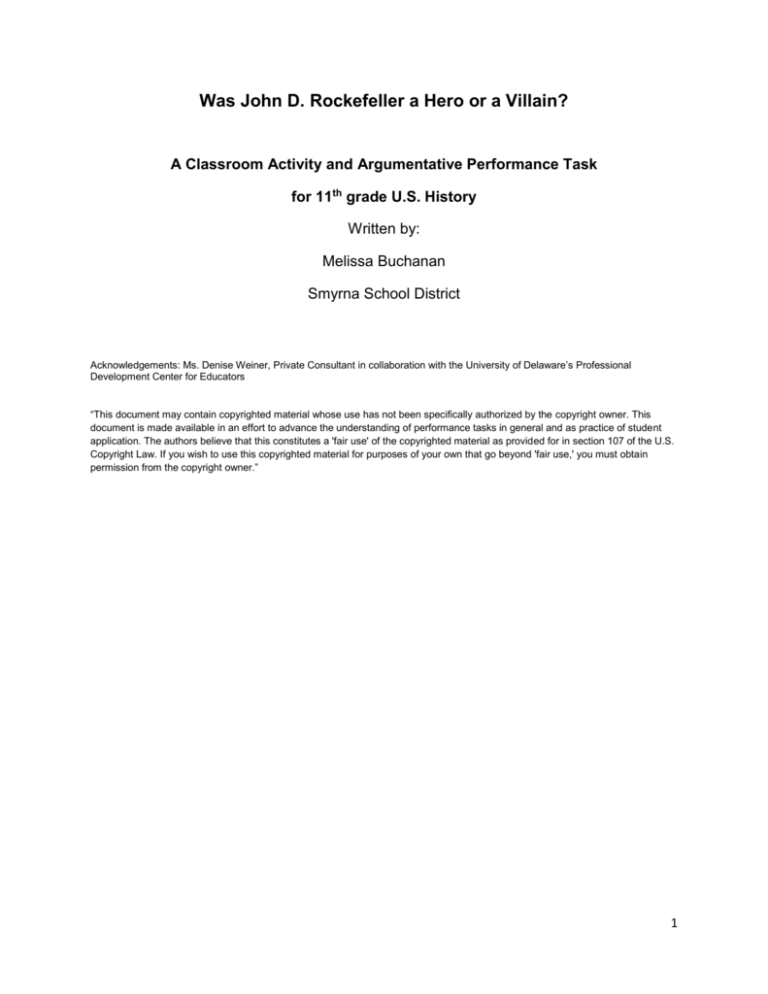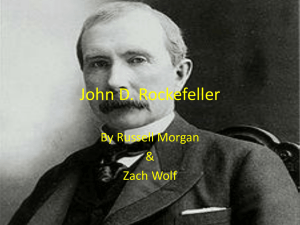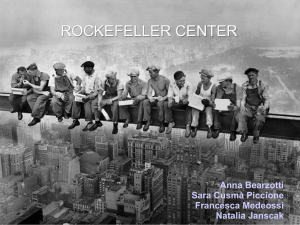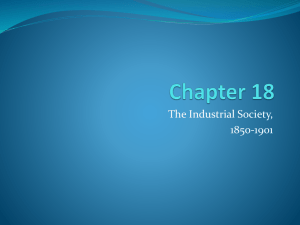Was John D. Rockefeller a Hero? - Delaware Department of Education
advertisement

Was John D. Rockefeller a Hero or a Villain? A Classroom Activity and Argumentative Performance Task for 11th grade U.S. History Written by: Melissa Buchanan Smyrna School District Acknowledgements: Ms. Denise Weiner, Private Consultant in collaboration with the University of Delaware’s Professional Development Center for Educators “This document may contain copyrighted material whose use has not been specifically authorized by the copyright owner. This document is made available in an effort to advance the understanding of performance tasks in general and as practice of student application. The authors believe that this constitutes a 'fair use' of the copyrighted material as provided for in section 107 of the U.S. Copyright Law. If you wish to use this copyrighted material for purposes of your own that go beyond 'fair use,' you must obtain permission from the copyright owner.” 1 Classroom Activity: What makes a Historical hero? The Classroom Activity introduces student to the context of a performance task, so they are not disadvantaged in demonstrating the skills the task intends to assess. Contextual elements include: an understanding of the setting or situation in which the task is placed, potentially unfamiliar concepts that are associated with the scenario; and key terms or vocabulary students will need to understand in order to meaningfully engage with and complete the performance task. The Classroom Activity is also intended to generate student interest in further exploration of the key idea(s). The Classroom Activity should be easy to implement with clear instructions. Please read through the entire Classroom Activity before beginning the activity with students to ensure any classroom preparation can be completed in advance. Throughout the activity it is permissible to pause and ask students if they have any questions. Resources Needed: Chart paper or blank paper for students to record responses Copies or displays of Kindly/Unkindly Remembered Heroes and Two Historians Accounts of Ronald Regan Learning Goal(s): Students will understand the context of the key concepts related to the topic of competing historical narratives as specified in History Standard Three: Students will compare competing historical narratives, by contrasting historians’ choice of questions, use and choice of sources, perspectives, beliefs, and points of view, in order to demonstrate how these factors contribute to different interpretations. 2 Classroom Activity This classroom activity and performance task could be used at the conclusion of an Industrialization unit or as a stand-alone prompt. It addresses the following questions: How does history remember John D. Rockefeller? Should Rockefeller be remembered as a historical hero or historical villain? Begin Classroom Activity Facilitator: Ask the students or have them write What is the definition of a hero? Of a villain? Teacher should survey answers or at least share that the definition of a hero is a man of distinguished courage or ability, admired for his brave deeds and noble qualities. A villain is a cruelly malicious person who is involved in or devoted to wickedness or crime. What ultimately makes a historical person remembered kindly – historical hero or remembered harshly - a historical “villain”? Facilitator: Have students create a list of activities, characteristics, and/or traits that identify someone as kindly or harshly. Examples of “hero” characteristics may include: caring, sharing, involved, charitable, inventor, etc. Examples of “villain” characteristics my include: law breaker, evil, bigot, unkind, used force, etc. Facilitator: From the list created by the students, have them identify a person from history that has been remembered as kindly due to the actions, characteristics, or traits they have listed. Then repeat the process for persons remembered as harsh. 3 The answers will vary but answers could look like this: Remembered Kindly Historical Heroes President/ General George Washington President Abraham Lincoln Reverend Martin Luther King Jr. Susan B. Anthony President Franklin Roosevelt Traits The General that led America through the war with Britain – Brave, Strong, Leader President during the Civil War and helped unify the nation and free the slaves – Moral, Dedicated, Kind Lead the Civil Rights movement and helped to create unity in America - Moral, Leader, Great orator Fought for and championed for Women’s Suffrage and Rights – strong, determined President that led America through the Depression and World War II - Showed strength through adversity Facilitator: Then have the students repeat the process for historical villains. (Again this is just a sample) Remembered Unkindly Historical Villains General Benedict Arnold President Jefferson Davis Governor George Wallace President Richard Nixon Traits He defected to the British Army in the Revolutionary War – traitor to his country President of the Confederacy and lead the resistance against America during the Civil War – traitor to his country Refused to allow African Americans into the University of Alabama in 1963 – immoral, unkind, divisive Lied about this conduct in the Watergate scandal and then resigned from the Presidency – sneaky, untrustworthy Facilitator should ask the students: Can historians have different interpretations of the same person? Ultimately, how history remembers different historical characters is up to the historian and the sources that are chosen. If a historian chose to look at Lincoln’s war tactics or his use of martial law (removing all trial by jury and ruling the civilians with the military) during the Civil War, they might feel that instead of promoting liberation he was causing the opposite. Ultimately, as historians review history different interpretations are created and the facts re-analyzed to determine if someone truly was a historical villain or hero. 4 Share with students the following historians viewpoints on Ronald Reagan ACCOUNT 1 ACCOUNT 2 Reagan's charm, geniality, and ability to connect with average citizens as well as world leaders earned him the nickname "The Great Communicator." Through his speeches and actions, Reagan restored the confidence of the American public in the office of the president. Decades after he left office, Reagan's legacy remained strong with admirers wanting to add his portrait to Mount Rushmore and to US currency. Reagan's hands-off leadership style manifested into an inability to control his administration from potentially illegal activities, e.g. the "Iran-Contra" scandal. His "troika," the nickname given to Chief of Staff James Baker, Deputy Chief of Staff Michael Deaver, and Counselor Edwin Meese, made many of Reagan's key administrative decisions for him. Source: ProCon.org. (2014, May 1). Ronald Reagan - ProCon.org. Retrieved April 30, 2015, from http://reagan.procon.org/ Facilitator: Ask students if one of the accounts is more favorable than the other? [ACCOUNT 1 is considered “Pro” and ACCOUNT 2 is considered “Con”] How does the author use text or rhetoric to persuade the reader? [ACCOUNT 1 – positive words like charm, geniality, connect, restored confidence, admirers. ACCOUNT 2 – inability, illegal, scandal.] Facilitator says: “In your performance task, you will be learning about John D. Rockefeller and how historians have viewed his actions with the Standard Oil Company. The work you did today should help prepare you for the research and writing you will be doing in the performance task.” Note: Facilitator should collect student notes. 5 Scoring Rubrics (Teacher Use Only) Part I – Research Questions Research Questions: Part 1 - Research Questions: After you have reviewed the research sources, answer the questions below. Your answers to these questions will be scored. Also, they will help you think about the sources you have read and viewed, which should help you write your essay. 1. Explain how the image in Source #1 supplement the information provided in two of the other sources. Justify your response by citing one piece of evidence from each of the two sources in your explanation. Identify the source of each piece of evidence by title or number. Score Rationale 2 Response provides an adequate evidence-based explanation of how the [image/table/map] in Source #1 [supplements/ contradicts] the information in two other sources. The explanation is supported by one piece of evidence from each of the two other sources. Student cites the source for each piece of evidence. Response provides a limited evidence-based explanation of how the [image/table/map] in Source #1 [supplements/contradicts] the information in two other sources. The explanation is supported by one piece of vague or loosely related evidence from each of the two other sources. Student cites the source for each piece of evidence. OR Response provides an adequate evidence-based explanation of how the [image/table/map] in Source #1 [supplements/ contradicts] the information in two other sources. The explanation is supported by two pieces of evidence from one source. Student cites the source. 1 OR Response provides an adequate evidence-based based explanation of how the [image/table/map] in Source #1[supplements/ contradicts] the information in two other sources. The explanation is supported by one piece of evidence from one source. Student cites the source. OR Response provides an adequate evidence-based based explanation of how the [image/table/map] in Source #1 [supplements/ contradicts] the information in two other sources. The explanation is supported by two pieces of evidence, one from each of the two other sources. Student does not cite the source for each piece of evidence. 0 The response is incorrect, insufficient, or irrelevant for this question. 6 2. Some of the sources suggest Rockefeller positively contributed to society. Provide one piece of evidence from each of two different sources and explain how each piece of evidence supports the claim that Rockefeller was a positive force. Identify the source of each piece of evidence by title or number. Score Point 2 Description Response is an identification and an adequate evidence-based justification of which source has the most relevant information for students researching Rockefeller’s contributions supported by two pieces of evidence from the identified source. Response is an identification and a limited/partial evidence-based justification of which source has the most relevant information for students researching Rockefeller’s contributions supported by two vague or loosely related pieces of evidence from the identified source. 1 OR Response is an identification and an adequate evidence-based justification of which source has the most relevant information for students researching Rockefeller’s contributions supported by one piece of evidence from the identified source. 0 Response is an explanation that is insufficient, incorrect or irrelevant. Just identifying the source is insufficient. 3. Indicate in the boxes which source(s) would be relevant to students researching the subtopics in the left column. Some sources may have more than one box selected. KEY Source #1 Source #2 Source #3 Source #4 Source #5 Source #6 Oil refineries Rockefeller’s Generosity South Improvement Company X X X X X X X X 7 Part 2 Scoring Rubric 8 9 Resources: Source 1: pbs.org Source 2: http://www.loc.gov/pictures/item/2007675471/ Source 3: http://www.pbs.org/wgbh/americanexperience/features/primaryresources/rockefellers-mcclures/ Source 4: http://www.pbs.org/wgbh/americanexperience/features/general-article/rockefellersclash/ Source 5 & 6: Taking Sides - Clashing Views in United States History Volume 2 by Larry Madaras and James SoRelle 10 Student Directions: Rockefeller Performance Task Task: The Smithsonian Museum of American History is creating an exhibit called Heroes of American History and the Rockefeller family is petitioning to have John D. Rockefeller included in this exhibit. The historians at the museum feel that Rockefeller may be deserving of this honor but are being swayed by the historical accounts of John D. Rockefeller. Does Rockefeller deserve a “Hero of American History” exhibit at the Smithsonian Museum? Read the historical sources that follow and determine: Whether they present Rockefeller kind or harsh light Whether they are trustworthy, reliable sources Ultimately you must determine whether you believe Rockefeller to be a historical hero or a historical villain and if he is deserving of this historical exhibit. Directions for Beginning: You will now examine several sources. You can re-examine any of the sources as often as you like. Research Questions: After examining the research sources, use the remaining time in Part 1 to answer the three questions about them. Your answers to these questions will be scored. Also, your answers will help you think about the research sources you have read and viewed, which should help you write your argumentative essay. You may refer back to your scratch paper or look at your notes when you think it would be helpful. Answer the questions in the spaces below the items. Your written notes on scratch paper will be available to you in Part 1 and Part 2. 11 Source 1: An overview of Rockefeller’s company, earnings and philanthropy: (edited from PBS.org) At the age of 24 Rockefeller gained control over his own oil business. He understood that the only way to make profits in the oil business was to make the business as large as possible and to utilize all their “waste” products. In short, nothing was left to chance, nothing was guessed at, and nothing was left uncounted and measured. But Rockefeller faced considerable challenges. At the time, many legislatures had made it difficult to incorporate in one state and operate in another. As a result, Rockefeller and his associates owned separate corporations across dozens of states, making their management of the whole enterprise very difficult. In order to overcome this problem, Rockefeller’s lawyers created a new type of corporation. This corporation was called the Standard Oil Trust. The “trust” was a corporation of corporations. This made it easier for Standard Oil to do business, and by 1879, the Standard Oil Company did about 90 percent of the oil refining in the United States. Rockefeller was only 40 years old when he made this great achievement. From the mid-1890s until his death in 1937, Rockefeller’s activities were philanthropic. Rockefeller’s fortune peaked in 1912 at almost $900,000,000, but by that time he had already given away hundreds of millions of dollars. The University of Chicago alone received $75,000,000 by 1932. When he died in 1937, his estate totaled only $26,410,837. He had given most of his property to his charities and to his son and other heirs. 12 Source 2: Created in 1900, this political cartoon shows an artist’s view of Rockefeller. The Trust Giants Point of View “What a funny little government” 13 Source 3: A History of The Standard Oil Company written by Ida Tarbell, was a 19 installment piece on John D. Rockefeller and his companies. While he was best known for his Standard Oil Company, he was also known for consolidating all of the oil companies into one big trust. Written in 1890, Tarbell describes the South Improvement Company (created and run by Rockefeller) that helped consolidated the oil distributors of Cleveland into one large corporation. For several days an uneasy rumor had been running up and down the Oil Region. Freights were going up. Now an advance in a man’s freight bill may ruin his business; more, it may mean the ruin of the region… On the morning of February 26, 1872, the oil men read in their morning papers that the rise which had been threatening had come; moreover, that all member of the South Improvement Company were exempt from the advance. At the news all Oildom rushed into the streets. Nobody waited to find out his neighbor’s opinion. On every lip there was but one word, and that was “conspiracy.” For weeks the whole body of oil men abandoned regular business and surged from town to town intent on destroying the “Monster,” the “Forty Thieves” and the “great Anaconda” as they called the mysterious South Improvement Company. Curiously enough, it was chiefly against the combination which had secured the discrimination of the railroads – not the railroads which had granted it — that their fury was directed. They expected nothing but the robbery from the railroads, they said. They were used to that; but they would not endure it from men in their own business. No number of resolutions could wipe out the memory of the forty days of terrible excitement and loss which the region (Cleveland) had suffered. No triumph could stifle the suspicion and bitterness which had been sown broadcast through the region…Their sense of fair play, the saving force of the region in the days before the law and order had been established, had been violated. These were things that could not be forgotten. There henceforth could be no trust in those who had devised a scheme which, the producers believed, was intended to rob them of their business. 14 Source 4: John D. Rockefeller’s defense of his Southern Improvement Company: I do not remember how many refineries there were in (Cleveland) – say 25 or 30, more or less. Some of them were little. More than 75 and probably more than 80 per cent - certainly a great number – of the refiners at Cleveland were already crushed by the competition which had been steadily increasing up to the his time. They didn’t collapse, they had collapsed before. That’s the reason they were so glad to combine their interest if they so wished it… (They were) mighty glad to get somebody to come and find a way out. WE were taking all of the risks, putting up our good money. They were putting in all of their old junk… When it was found how much stock or money would be given in exchange for their plants we found no difficulty in proceeding rapidly with the negotiations, and nearly all came in…though it is true that a few of the refiners decided to remain out, and those were among the smallest and least able to compete with us. With these, our relations continued, entirely pleasantly, until at length, one by one, of their own volition, they were pleased to embrace the opportunity to join their interests with ours, the result of which in every case was most satisfactory to them. 15 Source 5: Matthew Josephson, a historian, wrote this piece in 1934 declaring Rockefeller a manipulator and conspirator to ending competition in the oil business. (Edited and adapted) Rockefeller had no friends and no diversions, who was “all business” as John T. Flynn describes him, now gave himself to incessant planning, planning that would defeat chance itself…Within a year or two, the firm of Rockefeller, Flagler & Andrews was the biggest refinery in Cleveland, producing 1,500 barrels (of oil) a day…the company moved steadily to the front of the field, surpassing its rivals in quality and outselling them by a small, though not certain or decisive margin. How was this done? In the struggle for business, Rockefeller’s instinct for conspiracy is already marked. The partnership with Flagler brought an access of fresh capital and even more credit. Then in a further step of collusion, this of profound importance, Rockefeller and Flagler approached the railroad which carried so many carloads of their oil toward the seaboard…and demanded from it concession in freight rates that would enable them to meet the advantages of other refining centers such as Pittsburg and New York. This company was now large enough to force the hand of the railroad…and they were granted their demands: a secret reduction of “rebate” on all their shipments of oil. Thanks to the collaboration of the railroad, he had placed his rivals in other cities and in Cleveland itself under a handicap, whose weight he endeavored to increase. Rockefeller saw disorganized conditions of the Pennsylvania oil fields and felt that reorganization would help the whole. The broad purpose [of the South Improvement Company] was to control and direct the flow of crude petroleum into the hands of a narrowed group of refiners. Saying nothing to others, bending over their r maps of the industry, Rockefeller and Flagler first drew up a short list of the principal refining companies who were to be asked to combine with them. Then having banded together a sufficient number, they would persuade the railroads to give them special freight rates – on the ground of ”evening” the traffic – guaranteeing equitable distribution of freight business, and this in turn would be a club to force other elements needed into union with them. They could control output, drive out competitors, and force all foreign countries throughout the world to buy their product from them at their own terms. Their plans moved forward rapidly all through 1871. Those who were approached by the promoters, those whom they determined to use in tier grand scheme, were compelled in a manner typical of all Rockefeller’s projects to sign a written pledge of secrecy: “I, --- ---, do solemnly promise upon my honor and faith as a gentleman what I will keep secret all transactions which I may have with the corporation known as the South Improvement Company.” The refiners to be combined under the aegis of the South Improvement Company were to have a rebate of from 40 to 50 per cent on the crude oil they ordered shipped to them and form 25 to 50 per cent on the refined oil they shipped out. The refiners in the Oil Regions were to pay twice as much by the new code as the Standard Oil Company at Cleveland. There competitors were simply to be decimated; the railroad systems were to open all their knowledge or rival 16 private business to the South Improvement Company, thus helping to concentrate all the oil trade into the few hands chosen. To the principal oil firms in Cleveland, Rockefeller went one by one, explaining the South Improvement Company, patiently pointing out how important it was…to save the Cleveland Oil trade. He would say: “You see, this scheme is bound to work. There is no chance for anyone outside. But we are going to give everybody a chance to get in. You are to turn your refinery over to my appraisers, and I will give you Standard Oil Company stock or cash, as you prefer for the value we put on upon it. I advise you to take the stock. It will be for your good.” Then if the men demurred…he would point out suavely that it was useless to resist; opposition would certainly be crushed. The offers made were for from a third to a half the actual cost of the property. 17 Source 6: Ron Chernow, a historian, wrote his piece in 1998 and says that Ida Tarbell’s account is swayed too much by her childhood and that historians have too often used her as a reliable source. Tarbell’s claims have made Rockefeller the main offender of all of the crimes committed by the South Improvement Company. (Edited and Adapted) After receiving McClure’s blessing, Ida Tarbell launched the series in November of 1902, feeding the American public rich monthly servings of Rockefeller’s past misdeeds. She went back to the early Cleveland days and laid out his whole career for careful inspection. All the degradations of a long career, everything Rockefeller had thought safely buried and forgotten, rose up before him in haunting an memorable detail. Before she was done, Ida Tarbell turned America’s most private man into its most public and hated figure… Although Tarbell pretended to apply her scalpel to Standard Oil with surgical objectivity, she was never neutral and not only because of her father (an oil business owner. Her brother, William Tarbell had been a leading figure in forming the Pure Oil Company, the most serious domestic challenger to Standard Oil, and his letters to her were laced with anti-Standard venom. Complaining of the trusts price manipulations in one letter, Will warned her, “Some of these fellows will get killed one of those days.” Will steered legions of Rockefeller enemies to his sister and even vetted her manuscripts. Amazingly, nobody made an issue of Tarbell’s veritable partnership with her brother in exposing his chief competitor. From the perspective of nearly a century later, Ida Tarbell’s series remains the most impressive thing ever written about Standard Oil – a tour de force of reportage that dissects the trust’s machinations with withering clarity. She laid down a clear chronology, provided a trenchant account of how the combine had evolved, and made the convoluted history of the oil industry comprehensible. Yet however, chaste and clearly reasoned her prose, it was always informed by indignation that throbbed just below the surface. It remains one of the great case studies of what a single journalist, armed with the facts, can do against seemingly invincible powers. Beginning with the Cleveland Massacre of 1872, Tarbell showed that Rockefeller had taken over rival refineries in an orchestrated atmosphere of intimidation. She exposed the deceit of an organization that operated through intimidation. She exposed the deceit of an organization that operated through a maze of secret subsidiaries in which the Standard Oil pipelines, which used their monopoly position to keep refractory producers in lines while favoring Standard’s own refineries. And she chronicled the terror tactics by which the trust’s marketing subsidiaries got retailers to stock their product exclusively….She also decried the trust’s threat to democracy and the subordination of state legislators, although she never guessed the depths of corruption revealed by Rockefeller’s papers. Nevertheless, as defenders of Rockefeller pointed out Tarbell committed numerous errors, and her work must be cited with caution. To begin with, the SIC was initiated by the railroads, not Rockefeller, who doubted the plan’s efficacy. And for all its notoriety, the SIC did not cause the oil crisis of the early 1870s but was itself a response to the glut that forced almost everybody to operate at a loss. It is also true that, swayed by childhood memories; Tarbell ennobled the Oil 18 Creek drillers, (of which her father was one) portraying them as exemplars of a superior morality. As she wrote: ”They believed in independent effort – every man for himself and fair play for all. They wanted competition, loved open fight.” To support this statement, she had to overlook the baldly anticompetitive agreements proposed by the producers themselves. Far from being free-marketers, they repeatedly tried to form their own cartel to restrict output and boost prices. And as Rockefeller pointed out, they happily took rebates whenever they could. The world of the early oil industry was not, as Tarbell implies, a morality play of the evil Standard Oil versus the brave noble independents of western Pennsylvania, but a harsh dogeat-dog world. Though billed as a history of Standard Oil, the Tarbell series presented Rockefeller as the protagonist and center of attention. Tarbell made Standard Oil and Rockefeller interchangeable, even when covering the period after Rockefeller retired. Sometimes it is hard to tell whether Rockefeller is a real person or a personification of a trust. Significantly, Tarbell chose for her epigraph the famous line from Emerson’s essay on self-reliance, “An Institution is the lengthened shadow of one man.” This great man approach to history gave a human face to the gigantic, amorphous entity known as Standard Oil but also turned the full force of public fury on Rockefeller. It did not acknowledge the bureaucratic reality of Standard Oil, with its labyrinth committee system, and stigmatized Rockefeller to the exclusion of his associates. However, path breaking in its time and richly deserving of its accolades, the Tarbell series does not finally stand up as an enduring piece of history. The more closely one examines it, the more it seems a superior screed masquerading as sober history. 19 Part 1 - Research Questions: After you have reviewed the research sources, answer the questions below. Your answers to these questions will be scored. Also, they will help you think about the sources you have read and viewed, which should help you write your essay. 1. Explain how the image in Source #1 supplement the information provided in two of the other sources. Justify your response by citing one piece of evidence from each of the two sources in your explanation. Identify the source of each piece of evidence by title or number. 2. Some of the sources suggest Rockefeller positively contributed to society. Provide one piece of evidence from each of two different sources and explain how each piece of evidence supports the claim that Rockefeller was a positive force. Identify the source of each piece of evidence by title or number. 3. Indicate in the boxes which source(s) would be relevant to students researching the subtopics in the left column. Some sources may have more than one box selected. Source #1 Source #2 Source #3 Source #4 Source #5 Source #6 Oil refineries Rockefeller’s Generosity South Improvement Company 20 Part 2 You will now review your notes and sources, and plan, draft, revise and edit your writing. You may use your notes and refer to the sources. Now read your assignment and the information about how your writing will be scored; then begin your work. Your Assignment The Smithsonian Museum of American History is creating an exhibit called Heroes of American History and the Rockefeller family is petitioning to have John D. Rockefeller included in this exhibit. The historians at the museum feel that Rockefeller may be deserving of this honor but are being swayed by the historical accounts of John D. Rockefeller. Today you will write a multi-paragraph argumentative essay in which you will take a stance on the topic of whether John D. Rockefeller deserves a “Hero of American History” exhibit at the Smithsonian Museum or not. Make sure you establish an argumentative claim, address potential counterarguments, and support your claim from the sources you have used. Develop your ideas clearly and use your own words, except when quoting directly from the sources. Be sure to reference the sources by title or number when using details or facts directly from the sources. Argumentative Essay Scoring: Your argumentative essay will be scored using the following: 1. Organization/purpose: How well did you state your claim, address opposing claims, and maintain your claim with a logical progression of ideas from beginning to end? How well did your ideas thoughtfully flow from beginning to end using effective transitions? How effective was your introduction and your conclusion? 2. Evidence/elaboration: How well did you integrate relevant and specific information from the sources? How well did you elaborate your ideas? How well did you clearly state ideas in your own words using precise language that is appropriate for your audience and purpose? How well did you reference the sources you used by title or number? 3. Conventions: How well did you follow the rules of grammar, usage, punctuation, capitalization and spelling? 21 Now begin work on your argumentative essay. Manage your time carefully so that you can 1. plan your multi-paragraph argumentative essay 2. write your multi-paragraph argumentative essay 3. revise and edit the final draft of your multi-paragraph argumentative essay Remember to check your notes and your pre-writing/planning as you write and then revise and edit your argumentative essay. 22




![men_who_built_america[1]](http://s2.studylib.net/store/data/005219845_1-7979604da89ac700f7913bb56611cc41-300x300.png)

